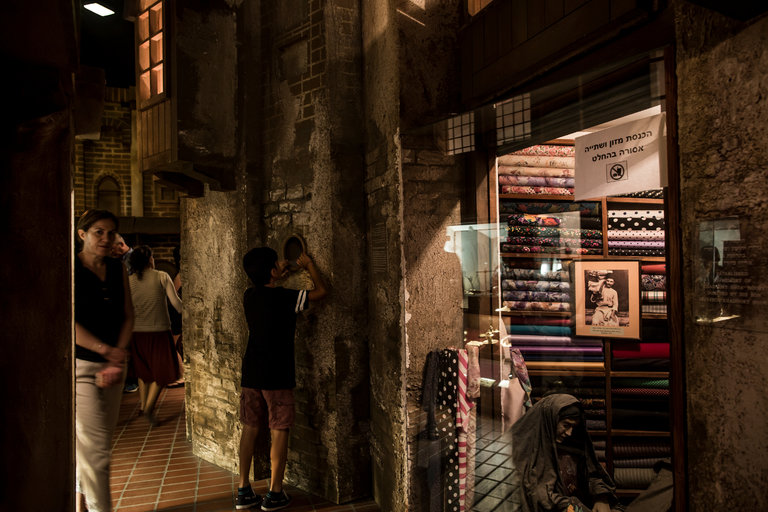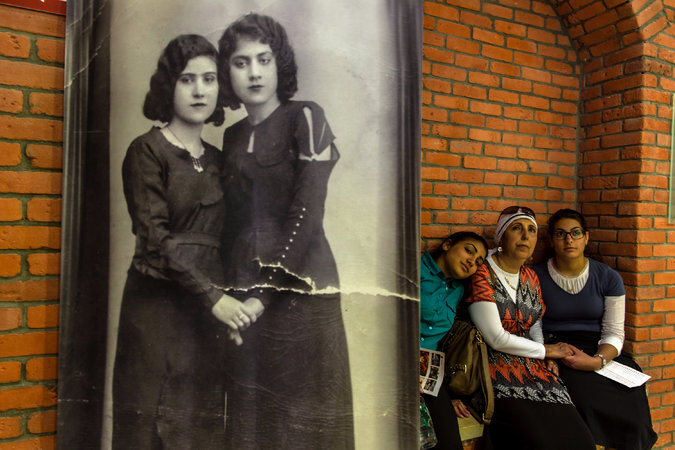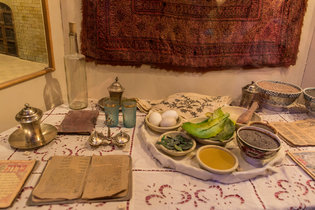In Israel, Iraqi Jews Reflect on Baghdad Heritage

GIVATAYIM, Israel — During a boisterous Passover Seder with her extended family, Sabiha Ziluf, 75, paused and said softly that she could still see the Baghdad streets of her childhood. “I would love to visit Bab al-Sharji,” she said, referring to an old neighborhood near where her aunt lived.
Ms. Ziluf, whose first name translates roughly to “morning” in Arabic, is one of countless Iraqi Jews in Israel taking fresh interest in a heritage once considered unseemly, even shameful. Facebook pages with tens of thousands of followers debate the fine points of Iraqi Jewish dialect, music and cuisine. A Babylonian heritage center near Tel Aviv has drawn daily crowds of more than 1,300 people during Passover, and its number of yearly visitors has increased by more than 50 percent since 2011.
Among those viewing the center’s reconstructions of the shops and crooked alleys of Baghdad’s old Jewish quarter were swarms of children, generations removed from those who experienced Babylon’s allure firsthand. “They are heroes,” Liel Ovadya, 13, said of the Jews of Baghdad, who included his grandmother Oshrat Berko, who immigrated to Israel at 15. As of 2014, there were 227,900 Jews of Iraqi descent living in Israel, according to government data.
Families with ties to Iraq are among several communities of Israelis from Arabic and North African countries newly embracing their origins after struggling to be accepted by the Ashkenazi Jews of Europe, who founded Israel and for decades dominated its political, military and academic elites. The resurgent interest comes as the number of Jews in Iraq has dwindled to nearly none, and as the Islamic State and other hostile groups are sowing chaos in the streets, shrines and graveyards where Jews lived, died and celebrated their faith for nearly three millenniums.
In recent interviews, many Israelis pointed to two unlikely cultural icons — Dudu Tassa, a 39-year-old rock star, and Eli Amir, a 78-year-old novelist — as forces that have accelerated Iraqi Jews’ efforts to preserve their past before it vanishes forever.
“The Dove Flyer,” a novel by Mr. Amir, and the 2014 film based on it, culminate in the 1951 Israeli airlift that brought nearly 110,000 Jews to Israel from Iraq with little more than the clothes on their backs. Arriving shortly after the 1948 Arab-Israeli war, the newcomers largely suppressed their culture, Mr. Amir said in an interview, because “their language was the enemy language and their music was the music of the enemy.”

“This was a kind of a terrible wound that each and every one of us tried to handle differently,” Mr. Amir said. His work, he said, was meant “to put my visiting card on the table of every Ashkenazi to let them know we didn’t come from the desert and caves and trees — that we came from a civilized country.”
Mr. Tassa, who was born in Tel Aviv, began an artistic journey that fused rock and traditional Arab music after discovering that his grandfather Daoud al-Kuwaiti had been one of the most important composers in the Arab world. A 2011 film chronicling that journey had a catchy title: “Iraq ’n’ Roll.”
Iraq’s Jewish history dates about 4,000 years to the birth of the biblical patriarch Abraham in Ur, where there is a shrine and archaeological digs. Long after Abraham left for what was then called Canaan, generations of Jews were sent to exile in Babylon, between the Tigris and Euphrates Rivers in what is now Iraq.
An Ottoman census in 1917 counted 80,000 Jews in Baghdad out of 202,000 residents, a community that Nissim Rejwan, the author of “The Jews of Iraq: 3,000 Years of History and Culture,” described as “perhaps the wealthiest, and certainly the best educated” in that era.
Ali Adeeb, who once worked for The New York Times in Baghdad and who now teaches at New York University, said that in the first half of the 20th century, Jews were not only major forces in Iraq’s financial institutions, but also produced the nation’s most renowned historian, most famous singer and most influential composers — including Mr. Tassa’s grandfather and great-uncle.
Iraqi Jews had always been the targets of sporadic attacks. But the danger soared with the rise of the Nazis’ influence in the 1930s as well as unhappiness around the Arab world with Zionism’s push for a Jewish state. A pogrom in June 1941, the Farhud, killed nearly 200 Jews in Baghdad.
Sammy Smooha, 74, a sociology professor at Haifa University, said his father was stabbed repeatedly during the pogrom but survived by pretending to be dead, stirring only after he had been loaded onto a truck with other bodies.

“This is the point where they realized there is no future in Iraq,” said Lily Shor, a guide and events manager at the Babylonian Jewry Heritage Center in Or Yehuda, outside Tel Aviv.
Still, as Mr. Amir describes in his work, there was disagreement among Jews on whether to take the airlift to Israel in 1951; thousands remained behind. For those who left, a new challenge awaited, said Dina Zvi Riklis, 66, a Tel Aviv filmmaker: starting over with nothing as a Mizrahi — the Israeli term for Jews from the Middle East and North Africa — in a young country dominated by Ashkenazis from Eastern Europe.
“I told my mother not to speak to me in Arabic,” Ms. Riklis said. “I denied that I came from Iraq.” She recalls her father being ridiculed by Israelis who called his traditional Arabic dishdasha, or a full-length garment, “pajamas.”
Many more Jews, including Ms. Shor, 59, slipped out of Iraq by the 1970s. In 2008, The New York Times reported that fewer than 10 Jews remained in Baghdad. Emad Levy, 51, who came to Israel in 2010 after a threat to his life, said he knew of just five Jews in the city. “They are well,” he said, protected by Muslim friends but dealing with endless violence and an absence of any civic activity.
With Jewish life all but extinguished in Baghdad, Ronit Azouri, the general manager of the heritage center, said the institution was “the only place you can see what it was like for Jews in Iraq.”
One of the center’s exhibits shows the Iraqi version of charoset, a staple of the Passover Seder plate, using date honey and nuts, and a Haggadah, the text guide to the Seder itself, in Iraqi Jewish dialect — largely drawn from Arabic but written in Hebrew letters.
Professor Smooha, who came to Israel on the airlift when he was 9, said some rapprochement between Iraqi Jews and their heritage had been occurring for more than a decade. But he said he saw new changes: In December, Israel began offering a stipend of about $950 a year, as well as assistance with prescription medication, to those who were affected by the Farhud (along with those from Algeria and Morocco who suffered under the Vichy government).
As for Mr. Tassa, he said that in merging his grandfather’s work with his own, he was forced to confront not only technical challenges but also his very identity. At concerts, he said, he has been “surprised to see three generations of audience,” adding, “The grandparents, the parents and the children all related to the show.”
Category: Baghdad, Heritage, Personal History



